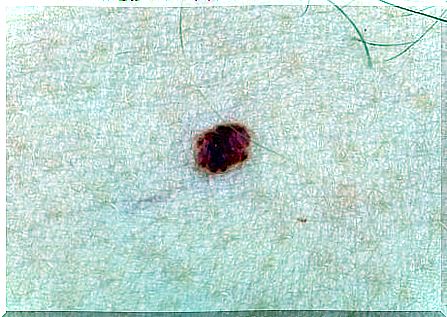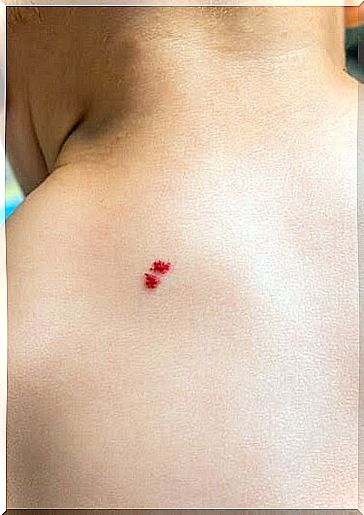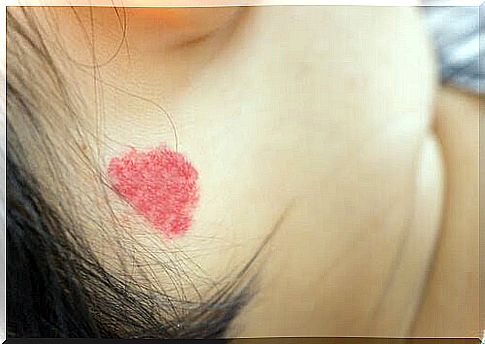What Should I Do If My Child Has Angioma?

Angiomas are often found on the face, scalp or back. However, they can occur in any area of the body. Some children are born with them and in rare cases, adults can also develop them.
Angiomas affect an estimated 8 to 10% of all children, but there are no exact figures. A large proportion of those who exist disappear during the first years of life on their own.
In medical terms, angiomas are benign tumors. Experts consider them to be a hereditary malformation. These tumors consist of an abnormally dense group of blood vessels. These may include capillaries, veins or arteries.
The angioma is first like a small red birthmark but can grow rapidly during the baby’s first year of life. As some angiomas grow, they become reddish spongy bulges. Angiomas never develop into malignant tumors.
Some studies have shown that angiomas are more common in premature babies. The same applies to children with low birth weight.
In addition, girls are three times more likely to develop them than boys. And while most cases develop only one angioma, some children develop more than one – especially in the case of twins.

Types of angiomas
These skin changes can be superficial or deep. If you think your child’s angioma is causing harm, talk to your pediatrician. A medical specialist will be able to make an accurate diagnosis and determine if it is serious or not.
The angioma falls into one of two different categories depending on where it is located and how it grows:
- Vascular tumors. This type of angioma grows from the surface of the skin. They develop rapidly, at first, but then disappear over time without treatment. In other words, they disappear spontaneously.
- Vascular malformations. These angiomas appear as flat spots on the skin. Over time, they get darker, and they do not go away on their own. They almost always develop on the face and have to do with capillary malformations.
The first category – the one with vascular tumors – is much more common than the second. Its development has two phases: a proliferative phase and an involutive phase.
The proliferative phase is when the tumor grows. This growth is rapid and usually occurs during the first 9 months of a baby’s life.
The involutive phase is the period when the angioma recedes. According to researchers, these tumors gradually disappear according to the child’s age, as follows:
- At 3 years of age, 30% of children no longer have angiomas.
- 50% of angiomas disappear before 5 years of age.
- 70% of 7-year-olds no longer have their angioma.
- By the age of 9, 90% of all angiomas have disappeared.
Treatment of angiomas
They require no treatment as the marks tend to disappear on their own. In general, they are not a threat to your child’s health.
Doctors simply recommend that you let it take the time it takes for the mark to disappear. All you have to do is keep it under observation.
However, some cases of angioma require medical treatment, as in the following cases:
- If the angioma is very aggressive and / or affects your child psychologically.
- When the angioma causes problems for another organ, for example when the tumor is close to the eye.
- If the angioma is located in the diaper area, as it can cause complicated sores.

If the angioma is close to the eye, it can cause vision problems for the baby. An angioma near the mouth is a common cause of difficulty swallowing.
As stated above, angiomas present in the diaper area can cause ulceration. These are extremely painful and difficult to heal.
If treatment is required, a doctor can usually administer glucocorticoids (steroid hormones) in varying amounts. The dose tends to be high, and the treatment usually lasts for several weeks.
Because glucocorticoids have side effects, such as difficulty sleeping and gastrointestinal problems, doctors only recommend treatment in more severe cases.
Complications
Superficial angiomas are the easiest to treat, and they are also the most common. But as I said, they can sometimes be deeper.
In fact, a small mark on the skin may be a symptom of a larger tumor beneath the surface. In this case, you need to consult a specialist to get an accurate diagnosis and know how to proceed.
The treatment of deeper vascular malformations usually consists of laser therapy. It is a very safe procedure and usually does not cause any pain.
Another advantage is that laser treatment very rarely leaves any scars on the skin.
Keep in mind that only 1% of vascular tumors lead to some more serious complications.









